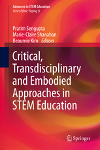- About MAA
- Membership
- MAA Publications
- Periodicals
- Blogs
- MAA Book Series
- MAA Press (an imprint of the AMS)
- MAA Notes
- MAA Reviews
- Mathematical Communication
- Information for Libraries
- Author Resources
- Advertise with MAA
- Meetings
- Competitions
- Programs
- Communities
- MAA Sections
- SIGMAA
- MAA Connect
- Students
- MAA Awards
- Awards Booklets
- Writing Awards
- Teaching Awards
- Service Awards
- Research Awards
- Lecture Awards
- Putnam Competition Individual and Team Winners
- D. E. Shaw Group AMC 8 Awards & Certificates
- Maryam Mirzakhani AMC 10 A Awards & Certificates
- Two Sigma AMC 10 B Awards & Certificates
- Jane Street AMC 12 A Awards & Certificates
- Akamai AMC 12 B Awards & Certificates
- High School Teachers
- News
You are here
Critical, Transdisciplinary and Embodied Approaches in STEM Education

Publisher:
Springer
Publication Date:
2019
Number of Pages:
566
Format:
Hardcover
Series:
Advances in STEM Education
Price:
139.99
ISBN:
978-3-030-29488-5
Category:
Collection
[Reviewed by , on ]
Peter Olszewski
09/13/2020
Over the last ten to twelve years, integrated STEM education has become an increasing field of interest. In addition to the growing international attention, integrated STEM education has prompted increase awareness for technological and disciplinary innovation at the K-16 levels. The issues of access, equality, and recent decolonizing efforts in public education are some of the current issues in STEM education. This book presents a series of papers that take into consideration two themes: The transdisciplinary approach in STEM education and Bodies, Hegemony and Decolonization in STEM education.
The papers presented in the text all originate from the symposium, “STEM as Critical Literacies” supported by the International Society for STEM in Education and the University of Calgary’s Weklund School of Education on September 27 – 30, 2017. There are 19 total papers in the text, which include an Introduction paper: Reimagining STEM Education: Critical, Transdisciplinary, and Embodied Approach, and Reflections: Engaging with Complexities and Imaging Possibilities Across the Boundaries of STEM. As pointed out in the Introduction on page 4, “integration” of STEM disciplines means an emergence of larger ideas and the representational practices that unify or transcend specific disciplines. The key question, however, is what is the nature of the emergent field of knowledge and practice, with particular focus on K-12 and college classrooms? The papers in this theme offer to the reader new imaginations of technological infrastructures, multidisciplinary contexts of inquiry, classroom activities, and researcher-practitioner partnerships where multiple disciplines come together in a seamless fashion. The papers in Theme Two start with the ideas of Takeuchi and Dadkhahfard that deepen the critique of functional rationality of STEM education from the perspectives of critical race theory and queer theory.
One of the papers that I enjoyed was in Chapter 4: Imagining the Sustainable Future Through the Construction of Fantasy Worlds. Here, eighth grade students are faced with the task of creating sustainable villages and fantasy worlds. The student primary used the villages and languages in Minecraft. Page 66 gives us the visual introductory picture the students saw and on page 68, a brainstorming map student’s drew is presented. Pages 74-75 give us pictures of two of the villages, Plumatopia and Whistle-Whistle-Click.
I recommend this text for those who have an interest in, what seems, the constant push for STEM Education. With the challenges, tensions, and ambiguities that come with implementing STEM initiatives, the papers in this text give the reader a sense of greater hope and a positive outlook that science, technology, engineering, and mathematics can be used in many creative ways in the classroom. In addition, for our students to be globally competitive after graduation, the more emphasis we can place on STEM, the better for our students.
Peter Olszewski is a Mathematics Lecturer at The Pennsylvania State University, The Behrend College, an editor for Larson Texts, Inc. in Erie, PA, and is the 362nd Chapter Advisor of the Pennsylvania Alpha Beta Chapter of Pi Mu Epsilon. His Research fields are in mathematics education, Cayley Color Graphs, Markov Chains, and mathematical textbooks. He can be reached at pto2@psu.edu. Webpage: www.personal.psu.edu/pto2.
See the publisher's web page.
- Log in to post comments




